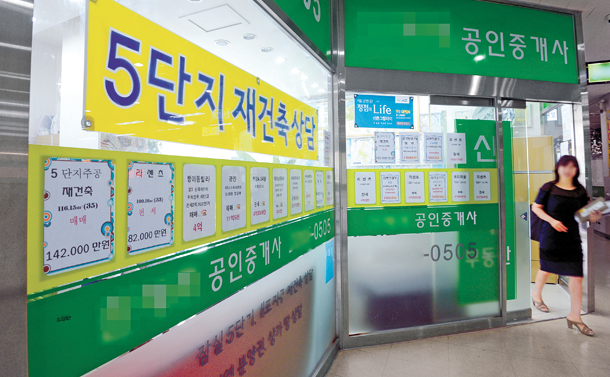Market to be flooded by rental apartments

Notice of rising apartment values posted at a real estate agency in Jugong 5 Danji, an apartment complex in Jamsil, southeastern Seoul, that is undergoing reconstruction. Rising housing prices and jeonse prices have driven many to consider lease apartments, whose quality has improved. [NEWSIS]
According to the real estate information provider Budongsan 114, from this month through November some 20,000 rental apartments will flood the market, including 4,421 New Stays, 2,559 rental apartments provided by the government, 646 so-called Haengbok apartments and 3,184 rented by private companies.
In addition, the Seoul government is letting out 1,387 apartment units.
New Stay units are long-term contracts in which tenants can stay for a minimum of eight years with monthly rent hikes limited to 5 percent a year. They will be offered in the greater Seoul area, including Incheon, Suwon and Hwaseong, as well as North Chungcheong, where the development of a so-called innovative city is under way.
This month SK E&C will be offering 1,086 units in the Sindongtan SK View Park 3 cha in Hwaseong, Gyeonggi. Next month Woomi Construction will offer 1,345 units in a so-called innovative city in North Chungcheong while Hanwha E&C will offer 1,213 New Stay apartments in Incheon.
In November Hyundai E&C will offer its first New Stay apartments.

There are no restrictions on people applying for the long-term rental apartments, including income and whether they already own an apartment.
Interest in government-provided rental apartments as well as so-called Haengbok apartments, which are also government rental apartments for young people, particularly college students, newlyweds and people new to jobs, is rising.
The government will be supplying 1,482 rental apartments in Yangju, Gyeonggi, which the tenants can purchase later, as well as 671 units in Gongju, South Chungcheong.
Additionally the government plans to provide 6,506 Haengbok apartments in 13 areas across the country by the end of the year. This fall alone 646 Haengbok apartments will be offered in Gimhae, South Gyeongsang, and Uijeongbu, Gyeonggi.
The government leased-apartments for low-income households will be offered for 90 percent of the average monthly rent in the surrounding neighborhood and the lease can run from five to 10 years.
People applying for government-leased apartment have to meet several prerequisites. They can’t own a residence. Households whose monthly income is less than 4.8 million won ($4,360) can apply for units that are 60 square-meters or smaller. Households with monthly incomes of 5.78 million won and under can apply for apartments between 60 square meters and 85 square meters.
If the applicant owns real estate that is not an apartment, such as farmland, it can’t be worth more than 215.5 million won. They can’t own a car worth more than 27.9 million won.
Applicants for Haengbok apartments have to attend schools or work jobs near the apartments. For example, if a person is studying in Seoul they can apply for a Haengbok apartment in areas close to Seoul such as Seongnam, Hanam, Uijeongbu and Gwacheon.
In October 1,387 Haengbok apartment units will be offered in Seoul alone. In Wirye, along the southeastern border of the nation’s capital, 998 units will be offered next month while 157 units will be offered in nearby Ogeum-dong and 128 units in nearby Geoyeo
The rents are 80 percent or lower than the average in the surrounding neighborhood and rent hikes will be limited to 5 percent a year. A person can live in the same apartment for a maximum 20 years. Instead of paying monthly rent, they have the option of paying a long-term deposit like jeonse.
Monthly incomes of applicants for Haengbok apartment have to be 70 percent or lower than the average income of urban laborers in the previous year. If they own real estate, it must be worth less than 126 million won. If they own a car, it can’t be worth more than 24.2 million won.
Private rental apartments are also expected to flood the market starting this fall. Both private rental apartments and New Stays are built by private construction companies. In the case of New Stays, the apartments are built on land owned by the government. To get private constructors to participate in New Stay complexes, the government offers tax benefits and financial aid to construction companies.
This month, Jungheung Construction will be offering 1,194 rental apartments in Dongtan 2 in Hwaseong. Woomi Construction and Keumkang are offering rentals in Seosan in South Chungcheong and Ulsan later this year.
Rental apartments were shunned in the past. They were considered housing for low-income households and many neighborhoods opposed their construction because they reduced real estate values. Today their image has improved along with the quality of the units.
Last month, when GS E&C started accepting applications for its New Stay apartment Dongtan Lake Xi the Terrace, it received 26.3 applications for every unit. This was the highest ratio for the nine New Stay apartment complexes.
An unstable real estate market has contributed to strong demand for rental apartments.
“Construction companies are showing interest in rental apartments to generate sustainable profits,” said Kim Min-hyung, a researcher at the Construction and Economy Research Institute of Korea.
BY HAM SEUNG-MIN [lee.hojeong@joongang.co.kr]










with the Korea JoongAng Daily
To write comments, please log in to one of the accounts.
Standards Board Policy (0/250자)